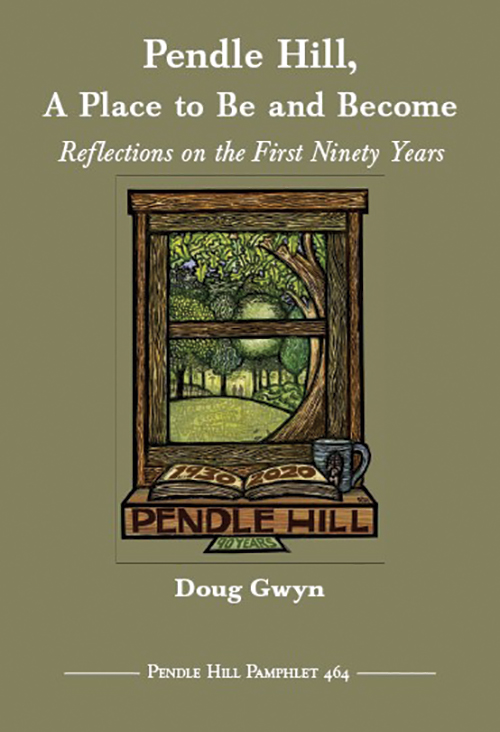
Pendle Hill, A Place to Be and Become: Reflections on the First Ninety Years
Reviewed by Diana Roose
March 1, 2021
By Doug Gwyn. Pendle Hill Pamphlets (number 464), 2020. 32 pages. $7.50/pamphlet.
As we travelled we came near a very great hill, called Pendle Hill, and I was moved of the Lord to go up to the top of it; which I did with difficulty, it was so very steep and high. . . . From the top of this hill the Lord let me see in what places he had a great people to be gathered. —George Fox, in Rufus Jones’s 1903 George Fox: An Autobiography
George Fox’s vision on Pendle Hill in Britain in 1652 marked the beginning of the Religious Society of Friends. Nearly 280 years later, in 1930, a Quaker retreat center named after the original Pendle Hill was opened near Philadelphia, Pa. Today, this “new” Pendle Hill has weathered with care and grace many complex challenges and uncertainties: war, inequality, racism, sexism, and environmental degradation.
A new Pendle Hill pamphlet by Doug Gwyn honors the center’s history through the lens of its buildings and grounds. Gwyn drew much of the source material from his 2014 book Personality and Place: The Life and Times of Pendle Hill (reviewed in FJ Nov. 2015, in which reviewer Valerie Brown describes it as “impeccably researched, thoughtfully and eloquently written, and a must-read”). The original buildings—the Main House and Barn—sit on seven and a half acres in Wallingford, Pa. They now provide meeting and worship spaces.
Additional buildings—Waysmeet, Upmeads, and Edgehill—were built in 1936–37, initially as staff residences but were later used for meetings, retreats, and a library. In 1945, seven more acres were added, and a large mid-nineteenth-century house (later named “Firbank”) was purchased to provide space for training, an art studio, and a library. Following the construction of Chace dormitory in 1958, rapid expansion in the 1960s brought Brinton House conference center, Crosslands, and Cadbury Court apartments (which were razed in 2016 because of structural problems). Throughout these years, Pendle Hill developed a robust resident and sojourner program where generations of Quakers and others came to learn, plan, create, and renew themselves.
In the 1990s, attention turned to stewardship of the natural world around Pendle Hill. Its grounds host more than 150 species of trees on 24 acres, including a 300-year-old beech tree and an offspring of the Treaty Elm under which William Penn made peace with the Lenape. The Perimeter Path nature trail and new organic gardens were added to enhance the smaller kitchen gardens.
It’s impossible to understand Pendle Hill fully without noting some of the many Quakers and others who have graced its grounds, including Anna and Howard Brinton, Paul Robeson, Martin Buber, Rabindranath Tagore, A.J. Muste, Dorothy Day, Elise and Kenneth Boulding, Dorothy and Douglas Steere, Jean-Paul Sartre, Bill and Fran Taber, Wendell Berry, Bayard Rustin, Eleanor Roosevelt, Muriel Lester, Sally and Parker Palmer, Vincent Harding, George Willoughby, George Lakey, and Niyonu Spann. Some came to retreat or teach, while others inspired ideas reflected in the pamphlet series, now including more than 460 pamphlets and over 60 books, producing what Gwyn calls “the most substantive and far-ranging Quaker literature of the twentieth century and into the present.”
Pendle Hill has served as a center for programs for World War II relief, conscientious objection, antiwar protests, community organizing, and anti-poverty efforts, as well as environmental programs and antiracism campaigns that continue to this day. As a retreat center where radical thoughts can be discussed and sifted carefully with Quaker values, the success of Pendle Hill rests largely upon its bold and forward-seeking programs and participants.
Today, the coronavirus pandemic has temporarily closed the campus and resident program. Online courses and talks, such as John Calvi’s widely viewed Zoom program “Love in a Time of Coronavirus,” signal new forms of discussion and coming together. Daily worship continues electronically with Friends from around the world. A new executive director, Francisco Javier Burgos, has brought energy and fresh perspectives. May the next 90 years be as productive as the past.
Diana Roose is a member and former clerk of Oberlin (Ohio) Meeting. Retired from Oberlin College, she has worked for American Friends Service Committee and Friends Committee on National Legislation, and attended many Pendle Hill consultations and retreats.


